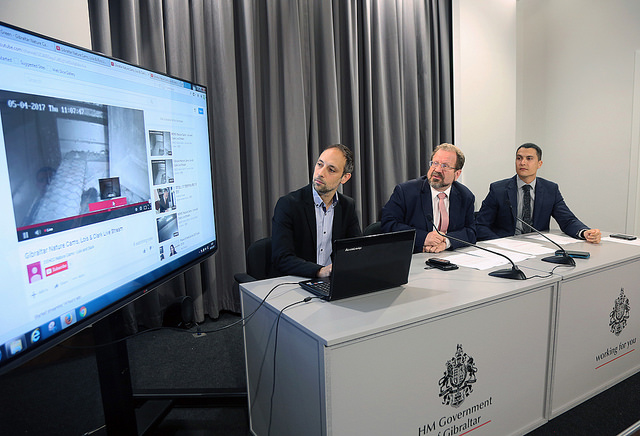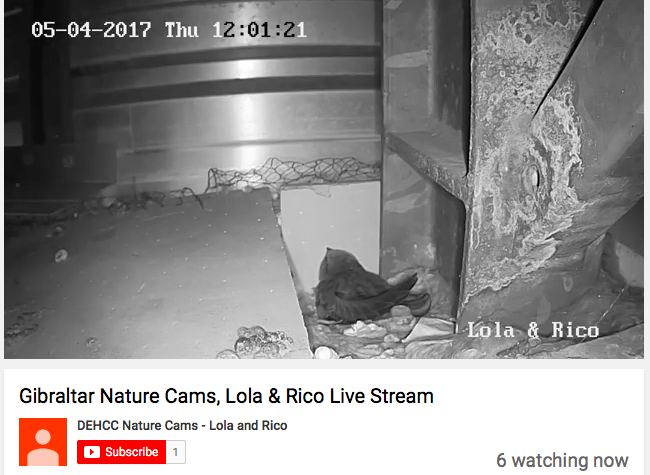May 04 - Viewers Can Now Watch Swift Nests On Live Camera
 The movement of swifts in Gibraltar can now be viewed in the comfort of your own home or classroom as the Department of the Environment, Heritage and Climate Change launches the second phase of its Gibraltar Nature Cameras Project with two live-feed cameras showing the nests of the Pallid Swift.
The movement of swifts in Gibraltar can now be viewed in the comfort of your own home or classroom as the Department of the Environment, Heritage and Climate Change launches the second phase of its Gibraltar Nature Cameras Project with two live-feed cameras showing the nests of the Pallid Swift.
In about 10 days to two weeks, viewers can see as Lola and Rico and Lois and Clark become parents to their clutches of eggs, while two further cameras will be switched on shortly.
These fast moving, sickle-shaped birds, signal the start of the spring and are a characteristic feature of the Spring and Summer skies of Gibraltar.
A spokesman for Number Six said: "Following the earlier deployment of the greatly successful live marine camera, the initiative will be used as part of the Department’s wider Environmental Education Programme aiming to increase knowledge of and protect both our natural and urban environments.
"It is hoped that the live-feed Swift cameras will help raise awareness on the fascinating lives of these birds, as well encourage the wider public to protect them and their nest sites. Swifts fly all the way down to tropical Africa and back every single year, and once they leave the nest as youngsters are known to spend several years continuously on the wing.
Two species of swifts have historically nested in built-up areas in Gibraltar; the Common swift characterised by its dark, almost black colour and the Pallid swift, which is paler brown. Older buildings in Gibraltar were constructed using traditional methods, leaving gaps under the eaves and gables. These have long been used by swifts for nesting. However, modern building styles and techniques have had an adverse effect on the local swift population by decreasing the habitat that these birds use for nesting.

The Government is placing nests around Gibraltar and it is the policy of the Development and Planning Commission to require the installation of swift nests in all new construction. There is a third species, the larger and much rarer Alpine swift, which nests in crags on the east side of the Rock.
Additional cameras showcasing Gibraltar’s rich wildlife, such as birds of prey, will be launched later this Spring. The Swift cameras can be viewed online from the DEHCC’s Thinking Green website www.thinkinggreen.gov.gi.
Minister for the Environment, Dr John Cortes said, “These cameras will bring our urban wildlife right into our homes. We will be able to follow the development of these swifts from eggs to fledging.
"In Gibraltar, we love our swifts. We do a great deal to protect them and their nests, so it’s only right that we should get to know them better."
{fcomment}
Latest News
- End The Disparity Between High-Cost GHA Contracts And Local Wage Stagnation Says Together Gibraltar
- Minister Cortes Attends St Mary’s University 175th Anniversary Service
- Ministry Of Equality’s Pride Conference A Resounding Success
- Government Conducts Emergency Response Exercise At Bleak House
- New Gibraltar-Based AI Marketing platform Zaturn Offers Free Trials
- Powerful Performance of Carmina Burana in the Spitfire Hall
- Man Sentenced to Six Years for Attempted Wounding with Intent
- Minister Santos Participates in Panel in CPA BIMR Conference
- GFIU Launches New E-Learning Module On Countering Ransomware Financing
- Minister Santos Holds Meeting With The Lived Experience Council



